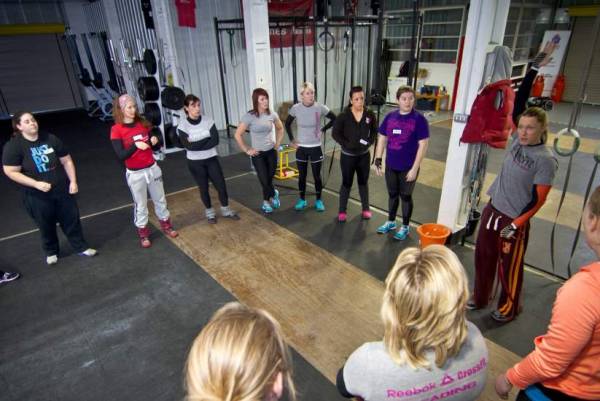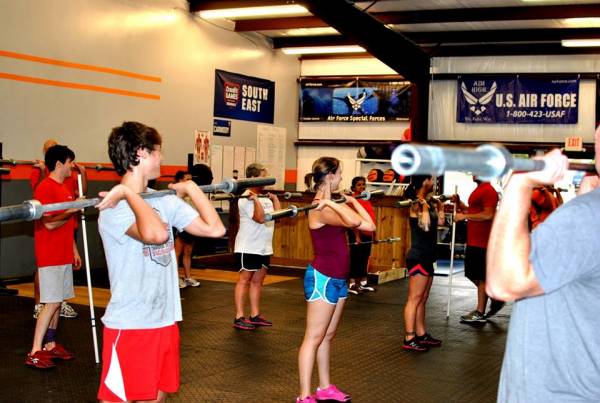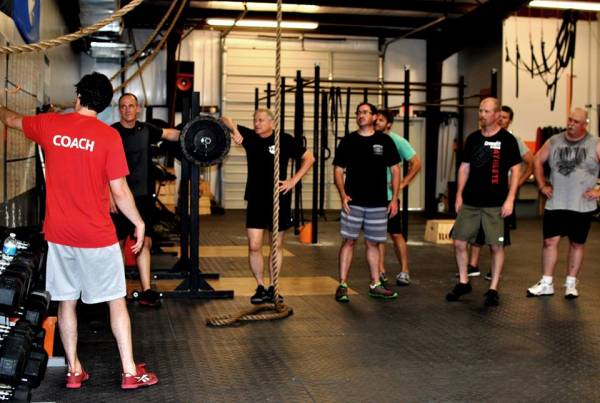If you’ve ever experienced an injury, you know it can be emotionally devastating. You think the world is ending and you feel claustrophobic in a body that no longer performs in a way you’ve come to expect. As a CrossFit coach, your own injuries (or imagining your way into what such an experience feels like) should cultivate a disposition of empathy for your athletes – which should also lead to taking your responsibility as a coach even more seriously.
Injury is an unfortunate reality inherent in all rigorous physical activity and no gym will ever be injury-free. But there are injuries I would consider preventable or easily avoided if coaches and affiliates adhere to some basic principles.
This article will focus on minimizing the risk factors for preventable injuries with non-competitive populations. I’m talking about librarians, schoolteachers, and people with desk jobs – people who are doing CrossFit primarily to become healthier, fitter, lose weight, and improve their quality of life, not make it to the CrossFit Games regionals. I’ve been running CrossFit South Brooklyn (CFSBK) for over six years, and below are some of the general principles we prioritize to keep our population safe.
A Culture of Safety
Two gyms following the exact same programming can have extremely different injury profiles based on their training cultures. Despite the excess of information and opinions found on the Internet about CrossFit, members of affiliates take cues primarily from coaches and other athletes at their gym. Your coaching staff has incredible leverage in shaping the attitudes your members develop while training.
At CFSBK, we highlight the importance of training longevity and movement quality on the first day of our introductory Foundations program, during which we review the elemental features of every exercise and principles that reify how to approach one’s training safely. (This write-up about training safety is required reading for participants.)
Having an introductory program at your gym, such as Elements or On-Ramp, is the first step toward creating a culture of safety. CFSBK’s emphasis on the principles of longevity and movement quality never ends, filtering into how we review exercises in classes, the kinds of articles we write on our blog, and the training advice we provide to our members in classes, conversations, and personal training sessions.
When participants graduate from Foundations, we require they start with our Fitness programming. We split our programming into Fitness and Performance versions, Fitness being the most basic version of our daily workouts. We make it clear that newer athletes can work up to advanced movements, but it requires time and mastering the fundamentals. Similarly, we always have options on our white board and blog about how to modify and scale movements for orthopedic issues. Maintaining an open dialogue, during class (and on your blog), helps athletes at all levels ask questions about how to make WODs work for them.

Even if a class is composed mostly of experienced athletes, we’ll still reinforce how to perform each movement well. What’s obvious to us as coaches is not intuitive to most of the people coming into our gym. We never presume people know how to do everything, and we’re always harping on the basics – a message that then informs the underlying ethos of our gym.
Excellent Coaching
An effective coach is able to empathize and work with a broad variety of body types and athletic goals, and make proper adjustments to WODs and movements to suit each particular athlete’s needs. Coaches should be able to respond quickly and intelligently when they see people working out of their element or lacking proper technique.
We wrote an open letter to new CrossFit coaches, and this paragraph sums it up well:
I believe a good coach earns the ability to teach movement – they don’t presume it. I encourage you to start by developing a personal understanding and appreciation of the skills you’re going to be teaching, and then slowly implement them into your coaching, both one-on-one and in group formats. It’s totally okay not to be teaching everything under the CrossFit sun in the beginning. Start with what you know and then get really good at teaching the fundamentals. After you’ve got a handle on your personal pedagogy, you can start to layer on more advanced skills. Trust me, it is okay if your early programming is very basic. Your clients won’t run away because they’re not working snatch and muscle-up progressions immediately. Respect the process and take the long, worthwhile road to becoming an excellent coach.
Minimizing injuries at your affiliate will happen if you commit to starting slow, and being humble and aware of where you still need to improve. CrossFit borrows from so many disciplines that it requires time and commitment to become competent with even one area.

Warm Up Time
Unless you’re primarily working with teenagers or people in their early twenties, the majority of people training at your gym sit for up to nine hours on a daily basis, have preexisting orthopedic conditions, or are simply deconditioned. Emphasizing sufficient warm-up time is critical to reducing risk for injuries. Not only should warm-up be incorporated into your classes, but it should be programmed specifically and intelligently before athletes attack their work weights or the prescribed weight for the WOD.
At CFSBK, we build warm-up time into our programming in accordance with the intensity of the workout or movements (more intense equals more warming up). Warm-ups involve basic movement prep such as DROMs and basic calisthenics. You should never see, “Okay, we’re doing Fran today, everyone throw 95 pounds on your bar and we’re starting in two minutes.” Such negligence pretty much guarantees an injury.
Developing Proficiency Through Your Programming
Performing lifts consistently, on a weekly basis, enables athletes to develop proficiency. CFSBK programs eight-week cycles of lifts. For example, our programming might include bench press on Mondays, squat on Wednesdays and Saturdays, clean and jerk on Saturdays, and deadlift every Sunday (in addition to whatever WODs we program). The more an athlete is exposed to something, the more proficient he or she becomes, and hence, also becomes less likely to get injured. Attempting to clean heavy on a randomized day instead of within an intentional training program leads to a higher likelihood that an athlete will do it wrong.
Furthermore, not everything that happens at your gym should require maximum effort or high volume. We program occasional not-for-time work and have back-off weeks to help our athletes recover. Such work is not an excuse to be lazy. Rather, by building these things into our programming, we make them quantifiable and repeatable so athletes can continue to monitor their progress on a long-term basis.

Concluding Thoughts
The majority of people doing CrossFit are in a group class environment where they work semi-autonomously for large portions of time. While it’s absolutely the coaches’ responsibility to teach correct movement, program sensibly, provide effective scaling options, and ensure the general safety of the group, it’s also the responsibility of the athletes to listen to their bodies, learn when to push and pull back, and eventually, understand their strengths, weaknesses, and limitations – and work to improve them. But if people at your gym are constantly falling off their training because of injuries, it might be time to reassess the effectiveness of your coaching, not your athletes’ capabilities.
One of the best ways to understand the efficacy and safety of your programming is to take classes at your own gym. If none of your coaches are following group class programming, not only is everyone removed from the perspective of how the classes run, but you don’t get to experience the cumulative physical stress to which your members are exposed.
Ultimately, don’t impress people with your intensity. Impress people with your excellent coaching. The intensity of CrossFit speaks for itself. Done correctly, these movements are incredibly potent at creating impressive levels of fitness, strength, and conditioning, but applied incorrectly or foolishly, they can also put someone in danger. You have the luxury of working with a group of highly motivated, passionate people – people crazy enough to do CrossFit in the first place. As an affiliate owner, and as a professional coach, you have a great amount of power, which includes a great amount of responsibility. Handle it well.
Photos 1 & 2 courtesy of Karl Buchholtz Photography.
Photos 3 & 4 courtesy of CrossFit Impulse.






